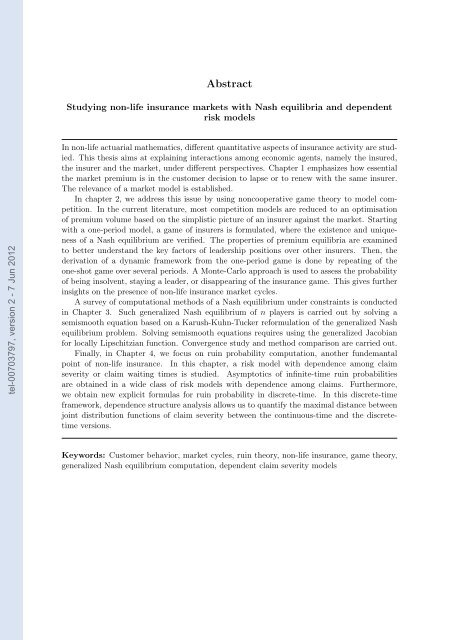Etude des marchés d'assurance non-vie à l'aide d'équilibres de ...
Etude des marchés d'assurance non-vie à l'aide d'équilibres de ...
Etude des marchés d'assurance non-vie à l'aide d'équilibres de ...
You also want an ePaper? Increase the reach of your titles
YUMPU automatically turns print PDFs into web optimized ePapers that Google loves.
tel-00703797, version 2 - 7 Jun 2012<br />
Abstract<br />
Studying <strong>non</strong>-life insurance markets with Nash equilibria and <strong>de</strong>pen<strong>de</strong>nt<br />
risk mo<strong>de</strong>ls<br />
In <strong>non</strong>-life actuarial mathematics, different quantitative aspects of insurance activity are studied.<br />
This thesis aims at explaining interactions among economic agents, namely the insured,<br />
the insurer and the market, un<strong>de</strong>r different perspectives. Chapter 1 emphasizes how essential<br />
the market premium is in the customer <strong>de</strong>cision to lapse or to renew with the same insurer.<br />
The relevance of a market mo<strong>de</strong>l is established.<br />
In chapter 2, we address this issue by using <strong>non</strong>cooperative game theory to mo<strong>de</strong>l competition.<br />
In the current literature, most competition mo<strong>de</strong>ls are reduced to an optimisation<br />
of premium volume based on the simplistic picture of an insurer against the market. Starting<br />
with a one-period mo<strong>de</strong>l, a game of insurers is formulated, where the existence and uniqueness<br />
of a Nash equilibrium are verified. The properties of premium equilibria are examined<br />
to better un<strong>de</strong>rstand the key factors of lea<strong>de</strong>rship positions over other insurers. Then, the<br />
<strong>de</strong>rivation of a dynamic framework from the one-period game is done by repeating of the<br />
one-shot game over several periods. A Monte-Carlo approach is used to assess the probability<br />
of being insolvent, staying a lea<strong>de</strong>r, or disappearing of the insurance game. This gives further<br />
insights on the presence of <strong>non</strong>-life insurance market cycles.<br />
A survey of computational methods of a Nash equilibrium un<strong>de</strong>r constraints is conducted<br />
in Chapter 3. Such generalized Nash equilibrium of n players is carried out by solving a<br />
semismooth equation based on a Karush-Kuhn-Tucker reformulation of the generalized Nash<br />
equilibrium problem. Solving semismooth equations requires using the generalized Jacobian<br />
for locally Lipschitzian function. Convergence study and method comparison are carried out.<br />
Finally, in Chapter 4, we focus on ruin probability computation, another fun<strong>de</strong>mantal<br />
point of <strong>non</strong>-life insurance. In this chapter, a risk mo<strong>de</strong>l with <strong>de</strong>pen<strong>de</strong>nce among claim<br />
severity or claim waiting times is studied. Asymptotics of infinite-time ruin probabilities<br />
are obtained in a wi<strong>de</strong> class of risk mo<strong>de</strong>ls with <strong>de</strong>pen<strong>de</strong>nce among claims. Furthermore,<br />
we obtain new explicit formulas for ruin probability in discrete-time. In this discrete-time<br />
framework, <strong>de</strong>pen<strong>de</strong>nce structure analysis allows us to quantify the maximal distance between<br />
joint distribution functions of claim severity between the continuous-time and the discretetime<br />
versions.<br />
Keywords: Customer behavior, market cycles, ruin theory, <strong>non</strong>-life insurance, game theory,<br />
generalized Nash equilibrium computation, <strong>de</strong>pen<strong>de</strong>nt claim severity mo<strong>de</strong>ls
















